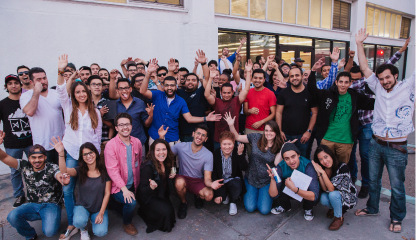Career Paths for the Graphic Design & Interactive Media Graduate: Exploring The Possibilities
With so many professional possibilities to explore as a media designer or graphic design, it’s no wonder this career path continues to grow in popularity for undergrads in the digital media arena. From a creative career in the entertainment and advertising industries to attaining a design job in science or healthcare that specializes in communication, there are plenty of media design careers available to the skilled media designer.
What Is the Role of A Graphic Designer or Interactive Media Designer?
As a graphic designer or interactive media designer, your tasks are varied, including a host of multimedia applications. Your primary responsibility involves the communication of information, messages, and/or entertainment through different digital and print mediums.
Besides creating 2-D and 3-D images and computer graphics, your role may also entail creating models, animations for film and video, digital illustrations, and even special effects, depending on the specific area you pursue. In turn, your designs will be utilized in an array of integrated media platforms, including but not limited to the internet, television, film, mobile technologies, and any other visual design platform.
Graphic designers and interactive media designers may also find their visual design work featured in more traditional channels, including newspapers, manuals, brochures, and other printed collateral. In general, your role will encompass the design of a visual presentation of some sort, whether it is used for entertainment purposes (such as the film industry), or for product enhancement, where your graphic design skills are being applied as a means of visual communication.
What Skills Do I Need To Become A Graphic Designer or Interactive Media Designer?
For those who are considering a career in graphic design or interactive media design, it’s important to be aware of the skills and resources needed to succeed. A fluency in computer software and coding is essential, as well as an intermediate/advanced level of proficiency in both Windows and Mac computer systems.
If you’re exploring a career as a UX designer, UI designer, or a career in interactive web design, a working knowledge of programming languages such as HTML (Hypertext Markup Language), XHTML (Extensible Hypertext Markup Language) and CSS (Cascading Style Sheets) is fundamental. Because nearly all web-based animation is created using Adobe Flash, you will want to become familiar with this program.
In addition, becoming adept at both Adobe Illustrator and Photoshop is key for anyone pursuing a career in the digital media arts. In addition to a high aptitude in computer technology and graphic design software, your creative, artistic, communication and organizational skills are crucial to your professional success once you enter the workforce.
In order to determine if a graphic design career path or one in interactive media design is the right fit for you, here are a list of pros and cons:
PROS & CONS of a Career in Graphic Design or Interactive Media Design: How To Become A Graphic Designer or Interactive Media Designer
- Digital media is a creative career allowing for creative expression
- Your design work may be seen by a large audience
- There are vast opportunities for advancement and growth within your field
- BLS statistics show that web design, UX design, UI design, and related fields will see an increase in growth within the next ten years
- A demanding schedule including deadlines can be stressful
- If you’re a freelance graphic designer, you must find your own work and maintain a steady flow of clients to remain financially stable
- In order to be successful (as a freelancer or full-time staff member), your schedule must cater to the client
- Because graphic design software and design technologies are constantly changing, you must remain up-to-date and constantly abreast of trends & tools within your industry
If you’re interested in becoming a graphic designer or pursuing a profession as a media designer, there are several ways of obtaining your goal. You may want to consider a 4-year graphic design and interactive media program geared specifically towards digital media design. In order to proceed, you’ll first need to have a high school diploma or equivalent before applying to colleges of your choice.
Once you’ve been accepted, your coursework will focus on image design and manipulation, web design and website maintenance, 3-D modeling, and digital video editing, as well as other computer software programs and digital tools.
Additionally, those enrolled in a bachelor’s degree design program can expect a combination of specialized classes and real-life, hands-on experiences to prepare them for the job market, including internships or similar opportunities.
In some instances, your bachelor’s program may require a senior design project, which can be used later on within your design portfolio as a representation of your work. In addition to becoming an expert in your field, building a strong design portfolio during your college years is imperative for your post-grad job search. For those who wish to seek a higher salary range and further their education, there are also master’s degree programs in graphic design, digital media, and animation. According to the U.S. Bureau of Labor Statistics (BLS), the digital media design industry is expected to experience an on-average job increase from 2014-2024. Computer graphic design positions can anticipate growth within the expanding mobile technology market, while the consumer demand for movies, video games, special effects and 3-D animation are also accountable for some of the projected growth within the job forecast.
Looking Ahead: Job Forecast For Graphic Designers or Interactive Media Designers
Due to the booming demands of our digital age, there are a variety of design positions within the animation, film, television, web, mobile technology, and video game industries.
Additionally, research has shown that employment may also be sought in alternative areas, such as law, medicine, science, architecture and business, where media designers assist in the enhancement of products and modes of communication within said industries.
It is also anticipated that between 2014-2024, employment for all art and design workers can expect a growth rate of 2%. Statistics show that the stagnation in employment growth within the industry was largely in part due to companies hiring labor from outside of the US. According to the BLS, multimedia artists and animators (which include digital media designers) earned a median annual wage of $63,970 and a median hourly wage of $30.76 (www.bls.gov) in 2015. Payscale.com also reports that the annual salary for a digital designer ranges from $38,633-$81,041 as of October 2016.
For more information about the Bachelor of Science in Graphic Design & Interactive Media program at NewSchool, contact our Enrollment Team.








 619-684-8800
619-684-8800

